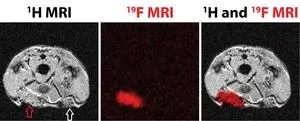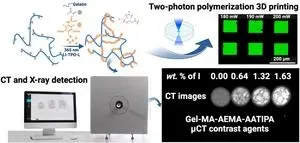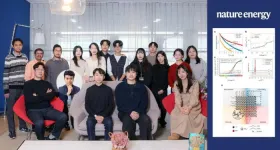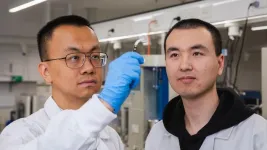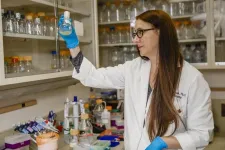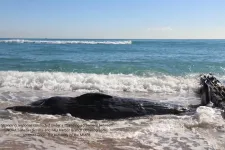(Press-News.org) Researchers from IOCB Prague and Ghent University have been working on improving the properties of gelatin-based materials, thereby expanding the possibilities of their use mainly in medicine. In a paper published in ACS Applied Engineering Materials, they have presented 3D-printable materials that can be easily monitored using an X-ray machine or through computed tomography (CT).
Gelatin-based materials have been a hot topic of research in the last ten years because they are straightforward to produce, non-toxic, inexpensive, biodegradable and - most importantly - because they promote cell growth. For this reason, they are pre-eminently used in plastic and reconstructive surgery. After a surgeon places an implant made of such material into a wound, the body gradually breaks it down and replaces it with tissue of its own. These substances thus accelerate wound healing and even enable the remolding of tissues, for example when performing breast reconstruction after mastectomy. In addition, the materials can be used for 3D printing implants tailored to individual patients.
So far, however, there has been one big obstacle to tackle, namely that it has been very difficult to track the breakdown of these materials in the body using conventional imaging methods. And this very hurdle is one that researchers from IOCB Prague are working to overcome. A radiopaque (i.e. X-ray-contrast) agent newly added to the materials makes it possible to trace how quickly implants shrink over time and whether they are intact or damaged.
One person behind this research at IOCB Prague is Ondřej Groborz from the research team of Tomáš Slanina (Photoredox chemistry group). He explains: ‘A whole series of academic papers is being written on this topic. The first of them introduces a gelatin-based material that can be monitored using magnetic resonance imaging. In our second article, recently published in Applied Engineering Materials, we endow the materials with X-ray and CT detectability.’ (Watch a video with the author.)
Because of this improvement, researchers can monitor these implants over time and observe their biodegradation and detect possible mechanical failures. These data are particularly useful in clinical practice. Based on the data obtained, the biodegradation of implants can be tailored to meet specific clinical requirements. This is because tissues in the human body grow at different rates, to which the properties of implants need to be adapted. The goal is to make these implants biodegrade at the same rate as healthy tissue grows.
Ondřej Groborz cooperates on this research with the Polymer Chemistry & Biomaterials Group (PBM) at Ghent University. Belgium is at the forefront in the medical use of implants with this structure. Moreover, the collaboration between IOCB Prague and Ghent University has potential to transcend into the commercial world. The two research institutions have already submitted a joint patent application concerning the use of the described materials in plastic and reconstructive surgery.
Original article: Groborz, O., Kolouchová, K., Parmentier, L., Szabó, A., Durme, B. V., Dunlop, D., Slanina, T., Vlierberghe, S. V. (in press). Photo-printable radiopaque hydrogels for regenerative medicine. ACS Applied Engineering Materials Article ASAP 2024. https://doi.org/10.1021/acsaenm.3c00533
IOCB Prague (the Institute of Organic Chemistry and Biochemistry of the Czech Academy of Sciences) is a leading internationally recognized scientific institution whose primary mission is the pursuit of basic research in chemical biology and medicinal chemistry, organic and materials chemistry, chemistry of natural substances, biochemistry and molecular biology, physical chemistry, theoretical chemistry, and analytical chemistry. An integral part of the IOCB Prague’s mission is the implementation of the results of basic research in practice. Emphasis on interdisciplinary research gives rise to a wide range of applications in medicine, pharmacy, and other fields.
END
Scientists from IOCB Prague have improved materials for reconstructive and plastic surgery
2024-02-21
ELSE PRESS RELEASES FROM THIS DATE:
Nanoscale manipulation of exciton–trion interconversion in a MoSe2 monolayer via tip-enhanced cavity-spectroscopy
2024-02-21
In a significant advancement for next-generation semiconductors, a collaborative research team, led by Professor Kyoung-Duck Park and Mingu Kang in the Department of Physics at POSTECH, Professor Yong Doug Suh in the Department of Chemistry at UNIST, who concurrently holds the position of Associate Director at the IBS Center for Multidimensional Carbon Materials (CMCM), and Professor Hyun Seok Lee in the Department of Physics at Chungbuk National University, has made groundbreaking discoveries in the field of two-dimensional (2D) semiconductors. Their findings, published in Nano Letters, shed light on the generation and control of trions, providing ...
Hyperbaric oxygen therapy tested for post-covid conditions
2024-02-21
High-dose pressurized oxygen can stress out old immune cells, leaving behind a younger, better functioning immune system. It helped with acute COVID, and now Anders Kjellberg is testing the method for post-covid as well.
Hyperbaric oxygen therapy, giving patients 100 percent oxygen at a pressure corresponding to 10-20 meters below sea level, has been around for almost 100 years. But the method lacks modern evidence from clinical studies, which also means that there is a lack of knowledge about dosage, all patients receive the same dose.
"When I started my research, I wanted to find out how the treatment should be dosed to different patients," says ...
Revolutionary breakthrough in solar energy: World’s most efficient QD solar cells developed
2024-02-21
A groundbreaking research breakthrough in solar energy has propelled the development of the world’s most efficient quantum dot (QD) solar cell, marking a significant leap towards the commercialization of next-generation solar cells. This cutting-edge QD solution and device have demonstrated exceptional performance, retaining their efficiency even after long-term storage. Led by Professor Sung-Yeon Jang from the School of Energy and Chemical Engineering at UNIST, a team of researchers has unveiled ...
New water batteries stay cool under pressure
2024-02-21
A global team of researchers and industry collaborators led by RMIT University has invented recyclable ‘water batteries’ that won’t catch fire or explode.
Lithium-ion energy storage dominates the market due to its technological maturity, but its suitability for large-scale grid energy storage is limited by safety concerns with the volatile materials inside.
Lead researcher Distinguished Professor Tianyi Ma said their batteries were at the cutting edge of an emerging field of aqueous energy storage devices, with breakthroughs that significantly improve the technology’s performance and lifespan.
“What ...
Focus on patient experience can improve diabetes care
2024-02-21
WASHINGTON—Health care providers who treat diabetes need to think beyond the clinical numbers, such as solely focusing on a person’s glucose goals. Taking the patient experience into account can improve the quality of care and facilitate attainment of treatment goals, according to a new position statement published in the Endocrine Society’s Journal of Clinical Endocrinology & Metabolism.
The position statement reflects the consensus of two virtual roundtables the Endocrine Society held in 2022. Participants ...
KIER’s success in the development of the world's top-level semi-transparent perovskite solar cells
2024-02-21
The Photovoltaics Research Department of the Korea Institute of Energy Research (hereafter KIER), working with the KIER Energy AI and Computational Science Lab, has achieved advancements in the stability and efficiency of semi-transparent perovskite solar cells. These cells have potential use in building windows and tandem solar cells*. The semi-transparent solar cells achieved a record-breaking efficiency of 21.68%, making them the most efficient amongst the perovskite solar cells using transparent electrodes in the world. Additionally, they showed ...
NIH grant to aid Rumbaugh’s biofilm dispersal research
2024-02-21
Most chronic wound infections share one thing in common: the presence of biofilms, which are composed of many different microorganisms that congregate as a mass, usually on some type of surface such as a wound bed. Biofilms are thought to be associated with up to 80% of infections, and their ability to stick together makes the biofilm and infection exceptionally difficult to kill.
To combat this health care challenge, researchers such as Kendra Rumbaugh, Ph.D., a professor in the Texas Tech University Health Sciences Center (TTUHSC) School of Medicine’s Department of Surgery, are pursuing biofilm dispersal agents such as ...
Study details toxic elements found in stranded whales, dolphins over 15 years
2024-02-21
Whales and dolphins get their nutrients and essential elements through their diet. While eating fish, squid, octopus, crustaceans and other marine mammals, they are also exposed to heavy metal contaminants.
Elevated levels of toxins have been found in stranded dolphins and whales along the Southeastern Coast of the United States. Monitoring toxic contaminants in these stranded marine animals, which serve as important sentinels of environmental contamination, and whose health may be linked to human health, is vital.
Yet, data remain sparse on how specific elements are distributed within an animal’s body, especially for many rarely encountered ...
Inaccurate pulse oximeter readings could limit transplants, heart pumps for Black patients with heart failure
2024-02-21
Racially biased readings of oxygen levels in the blood using pulse oximeters may further limit opportunities for Black patients with heart failure to receive potentially lifesaving treatments, such as heart pumps and transplants, a Michigan Medicine study finds.
“This is especially important because we know that Black patients are already less likely to receive heart pumps or transplants compared to their white counterparts, and these inaccurate readings can further widen a disparity that must be addressed by our health care system,” said first author Scott W. Ketcham, M.D., a third year ...
An awkward family reunion: Sea monsters are our cousins
2024-02-21
KANSAS CITY, MO—February 21, 2024—The sea lamprey, a 500-million-year-old animal with a sharp-toothed suction cup for a mouth, is the thing of nightmares. A new study from the Stowers Institute for Medical Research discovered that the hindbrain—the part of the brain controlling vital functions like blood pressure and heart rate—of both sea lampreys and humans is built using an extraordinarily similar molecular and genetic toolkit.
Research from the lab of Investigator Robb Krumlauf, Ph.D., published on February 20, 2024 in Nature Communications offers a glimpse into how the brains of ancient animals evolved. The team unexpectedly uncovered that ...

